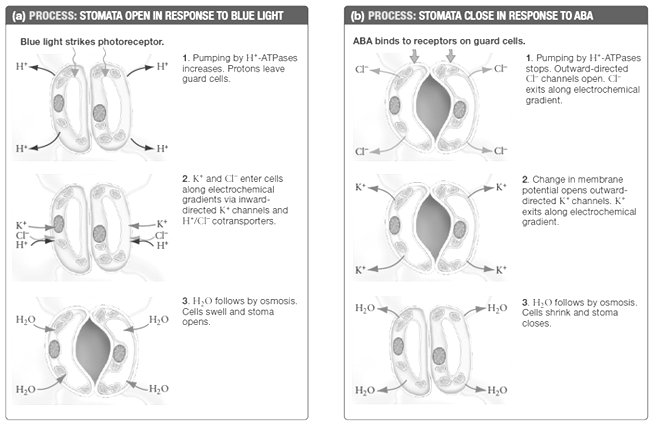Question
1. The mechanism of leaflet closure is somewhat similar to what happens during the shrinking of guard cells and closing of stomata (see the figure
1. The mechanism of leaflet closure is somewhat similar to what happens during the shrinking of guard cells and closing of stomata (see the figure below). When in the open position, special cells on the upper surface of Mimosa leaflets are filled with water and are under pressure. Explain how osmosis and flow of ions into and out of these special cells may be involved in leaflet closure and reopening.

Drag the terms on the left to the appropriate blanks on the right to complete the sentences.
loss of pressure,increase of the amount of water,turgor pressure,pressure increase ,osmosis ,lose pressure ,lose water ,osmotic pressure,increase pressure ,increase the amount of water ,loss of water.
Leaflets are kept in the open position due to_____ in cells on the upper surface. Leaflet closure is due to a rapid _____ in those cells. The cells _____ due to ions flowing out of the cells, followed by _______ by __________.
2. Leaflets of Mimosa pudica (common names: sensitive plant, touch-me-not) have a remarkable ability to close up in response to being touched or physically moved. How fast can the leaflets close? How does this occur? And more importantly, what benefit could this unusual response possibly provide to the plant
Which of the following terms best describes the leaflet movement?
a. Thigmonastic movements
b. Apical dominance
c. Thigmotropism
d. Thigmomorphogenesis
(a) PROCESS: STOMATA OPEN IN RESPONSE TO BLUE LIGHT Blue light strikes photoreceptor. H* H cr H HO HO- H* H* HO 1. Pumping by H*-ATPases increases. Protons leave guard cells. -K* H/C cotransporters. cr H* -HO 2. K and Center cells along electrochemical gradients via inward- directed K+ channels and 3. HO follows by osmosis. Cells swell and stoma opens. (b) PROCESS: STOMATA CLOSE IN RESPONSE TO ABA ABA binds to receptors on guard cells. cr K+- HO HO -ct -K+ 1. Pumping by H*-ATPases stops. Outward-directed CH channels open. Cl exits along electrochemical gradient. -HO 2. Change in membrane potential opens outward- directed K channels. K exits along electrochemical gradient. 3. HO follows by osmosis. -HO Cells shrink and stoma closes.
Step by Step Solution
3.43 Rating (159 Votes )
There are 3 Steps involved in it
Step: 1
1 Leaflets are kept in the open position due to turgor pressur...
Get Instant Access to Expert-Tailored Solutions
See step-by-step solutions with expert insights and AI powered tools for academic success
Step: 2

Step: 3

Document Format ( 2 attachments)
6094f7105b5e1_25415.pdf
180 KBs PDF File
6094f7105b5e1_25415.docx
120 KBs Word File
Ace Your Homework with AI
Get the answers you need in no time with our AI-driven, step-by-step assistance
Get Started


